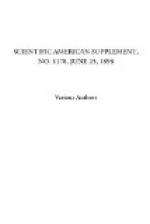It is not necessary for me to go into detail in explanation of the modern central station. You are all doubtless quite familiar with the general design, but if you will examine the detail drawings of the Harrison Street station, which I have brought with me, you will find that every effort has been made to provide for the economical production of steam, low cost of operating, good facilities for repairs and consequently low cost, and for permanency of service. You have but to go into any of the modern central stations in midwinter, to see them turning out anywhere from 10,000 to 80,000 amperes with a minimum of labor, to appreciate the fact that central station business is of a permanent and lucrative character.
To go back to the question of alternating currents, the work done in connection with the two-phase and three-phase currents and the perfection of the rotary transformer has resulted in introducing into central station practice a further means of economizing the cost of production—by concentration of power. According to present experience, it is (except in some extraordinary cases) uneconomical to distribute direct low-tension current over more than a radius of a mile and a half from the generating point. The possibility of transmitting it at a very high voltage, and consequently low investment in conductors, has resulted in the adoption of a scheme, in many of the large cities, of alternating transmission combined with low tension distribution. The limit to which this alternating transmission can be economically carried has not yet been definitely settled, but it is quite possible even now to transmit economically from the center of any of our large cities to the distant suburbs, by means of high potential alternating currents, distributing the current from the subcenter distribution by means either of the alternating current itself and large transformers for a block or district or else, if the territory is thickly settled, by means of a system of low-tension mains and feeders, the direct current for this purpose being obtained through the agency of rotary transformers.
There are various methods of producing the alternating current for transmission purposes. In some cases the generators are themselves wound for high potential; in others they are wound for 80 volts, and step-up transformers are used, carrying the current up to whatever pressure is desired, from 1,000 to 10,000 volts. In other cases dynamos are used having collector rings for alternating current on one side and a commutator for direct current on the other side of the armature, thus enabling you, when the peak in two districts of a city comes at two different times, to take care of this peak by means of the same original generating unit, furnishing direct low-tension current to the points near the central station and alternating current to the distant points. In other cases, where a small amount of alternating current is required on the transmission line, it has even been found economical to take direct current from a large unit, change it by means of a rotary transformer into alternating current, step up from 80 to, say, 2,000 volts, go to the distant point, and step down again to 80 volts alternating, and then convert again by means of a rotary transformer into low-potential direct current.




